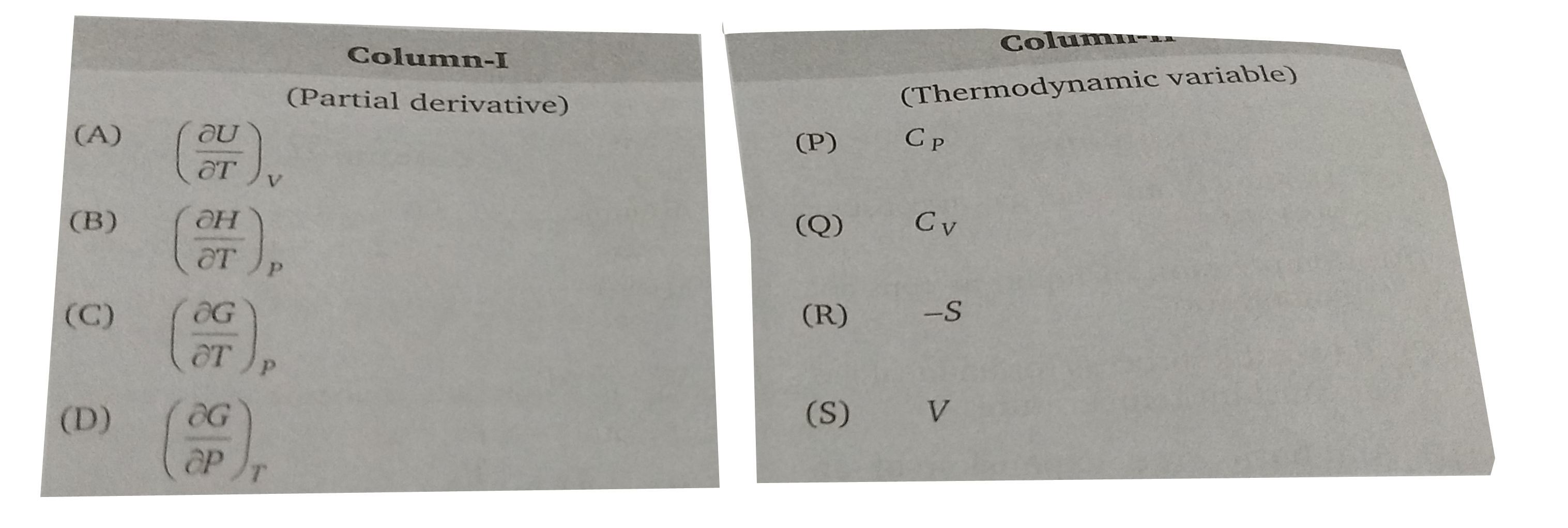ΔH and ΔU are the same of the reaction, N2(g)+O2(g)⇔2NO(g),
All reactants and products are gases where all gases are ideal. Solution in Punjabi
If both the statements are TRUE and STATEMENT-2 is the correct explanation of STATEMENT-1
If both the statements are TRUE but STATEMENT-2 is NOT the correct explanation of STATEMENT-1
If STATEMENT-1 is TRUE and STATEMENT-2 is FALSE
If STATEMENT-1 is FALSE and STATEMENT-2 is TRUE
The correct Answer is:B
Step by step video & image solution for DeltaH and DeltaU are the same of the reaction, N_(2)(g)+O_(2)(g)iff2NO(g), All reactants and products are gases where all gases are ideal. by Chemistry experts to help you in doubts & scoring excellent marks in Class 11 exams.
Updated on:21/07/2023Topper's Solved these Questions
- THERMODYNAMICSBOOK - NARENDRA AWASTHICHAPTER - THERMODYNAMICSEXERCISE - Level 3 - One Or More Answers Are Correct
1 Videos
- THERMODYNAMICSBOOK - NARENDRA AWASTHICHAPTER - THERMODYNAMICSEXERCISE - Level 3 - Match The Column
2 Videos
- THERMODYNAMICSBOOK - NARENDRA AWASTHICHAPTER - THERMODYNAMICSEXERCISE - Level 2 (Q.1 To Q.30)
1 Videos
- STOICHIOMETRYBOOK - NARENDRA AWASTHICHAPTER - STOICHIOMETRYEXERCISE - Level 3 - Subjective Problems
20 Videos
Similar Questions
Assume ideal gas behaviour for all the gases considered and neglect vibrational degrees of freedom. Separate equimolar sample. Separate equimolar samples of Ne, O2 , CO2 and SO2 were subjected to a two process as mentioned. Initially all are at same state of temperature and pressue.
Step I → All undergo reversible adiabatic expansion to attain same final volume, which is double the original volume thereby causing the decreases in their temperature.
Step → After step I all are given appropriate amount of heat isochorically to restore the original temperature.
Mark the correct option(s) :
View SolutionMatch the following columns

View SolutionWrite structure of 2,2-dimethylheptane.
View SolutionWhat volume of a liquid (in L) will contain 10 mole ? If molar mass of liquid is 280 and its density is 1.4 g/mL.
View SolutionPredict DeltaH gt DeltaU or DeltaH lt DeltaU . a. C("graphite") +O_(2)(g) rarr CO_(2)(g) b. PCI_(5)(g) rarr PCI_(3)(g) +CI_(2)(g)
View SolutionAssertion: DeltaH and DeltaE are almost the same for the reaction. N_(2)(g)+O_(2)(g) hArr 2NO_(g) Reason: All reactants and products are gases.
View Solutionuse the thermodymanmic information :
12N2(g)+12O2(g)ΔH∘=90.4Kj/mol
12N2(g)+O2(g)ΔH∘=33.8KJ/mol
2NO2(g)→N2O4(g)ΔH∘=−58.0KJ/mol
to Calcualate ΔH∘ Kj /mol for the reaction :
2NO2(g)+O2(g)→N2O4
View SolutionStatement -1 in the following reaction :
C(s)+O2(g)→CO2(g),ΔH=ΔU−RT
Statement -2: ΔH Is related to ΔU by the equation ,
ΔH=Δ+ΔngRT
View SolutionConsider the following reactions .In which case the formation of product is favoured by decreasein pressure? (1) CO_(2)(g)+C(s)hArr2CO(g),DeltaH^(@)=+172.5Kj (2) N_(2)(g)+3H_(2)(g)hArr2NH_(3)(g) hArr2NH_(3)(g),DeltaH^(@)=-91.8KJ (3) N_(2)(g)+O_(2)(g)hArr2NO(g),DeltaH^(@)=181KJ (4) 2H_(2)O(g)hArr2H_(2)(g)+O_(2)(g),DeltaH^(@)=484.6KJ
View SolutionΔH and ΔU are the same of the reaction, N2(g)+O2(g)⇔2NO(g),
All reactants and products are gases where all gases are ideal.
View SolutionIn the reaction N2(g)+O2(g)⇔2NO(g),ΔH=+180.7kJ. On increasing the temperature the production of NO
View Solutionअभिक्रिया H2(g)+I2(g)→2HI(g) के सभी अभिकारक तथा उत्पादों के रूप में अभिक्रिया की औसत दर को लिखिए।
View SolutionFor the gas phase reaction 2NO(g)hArrN_(2)(g) + O_(2)(g) , DeltaH = -43.5 kcal,which one of the following is true for N_(2)(g) + O_(2)(g)2NO(g)
View SolutionWhat would the effect on the yield of products be if temperature of the following reaction systems is changed at equilibrium ?
(1) N2(g)+O2(g)⇔2NO(g),ΔH>0
(2) 2SO2(g)+O2(g)⇔2SO3(g),ΔH<0
View SolutionAssertion (A) : ΔHandΔU are same for the reaction N2(g)+O2(g)→2NO(g)
Reason (R ): All the reactants and products are gases.
View SolutionGaseous N2O decomposes at 298 K and forms N2(g) and O2(g).The ΔH for the reaction at 1 atm pressure and 298 K is −163.15kJ. What is the value of ΔU for the decomposition of 200 g of N2O under the same conditions?
View Solution
